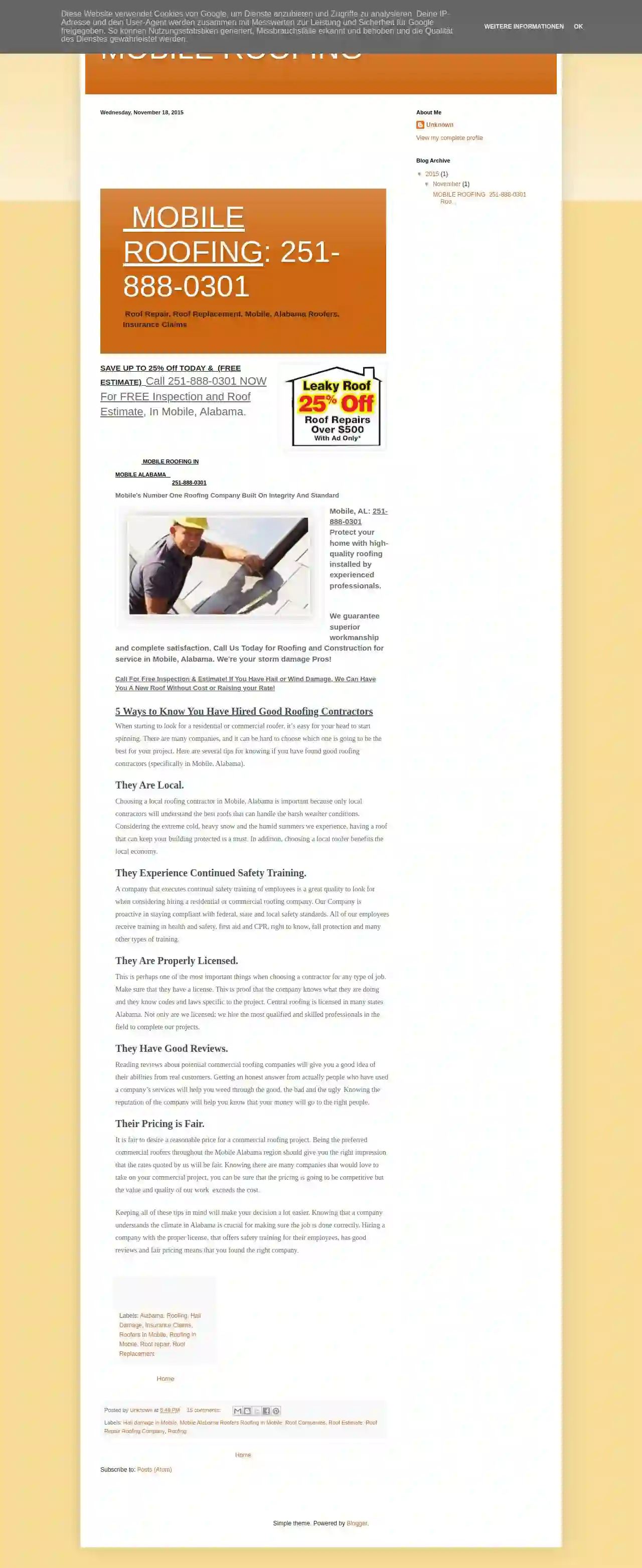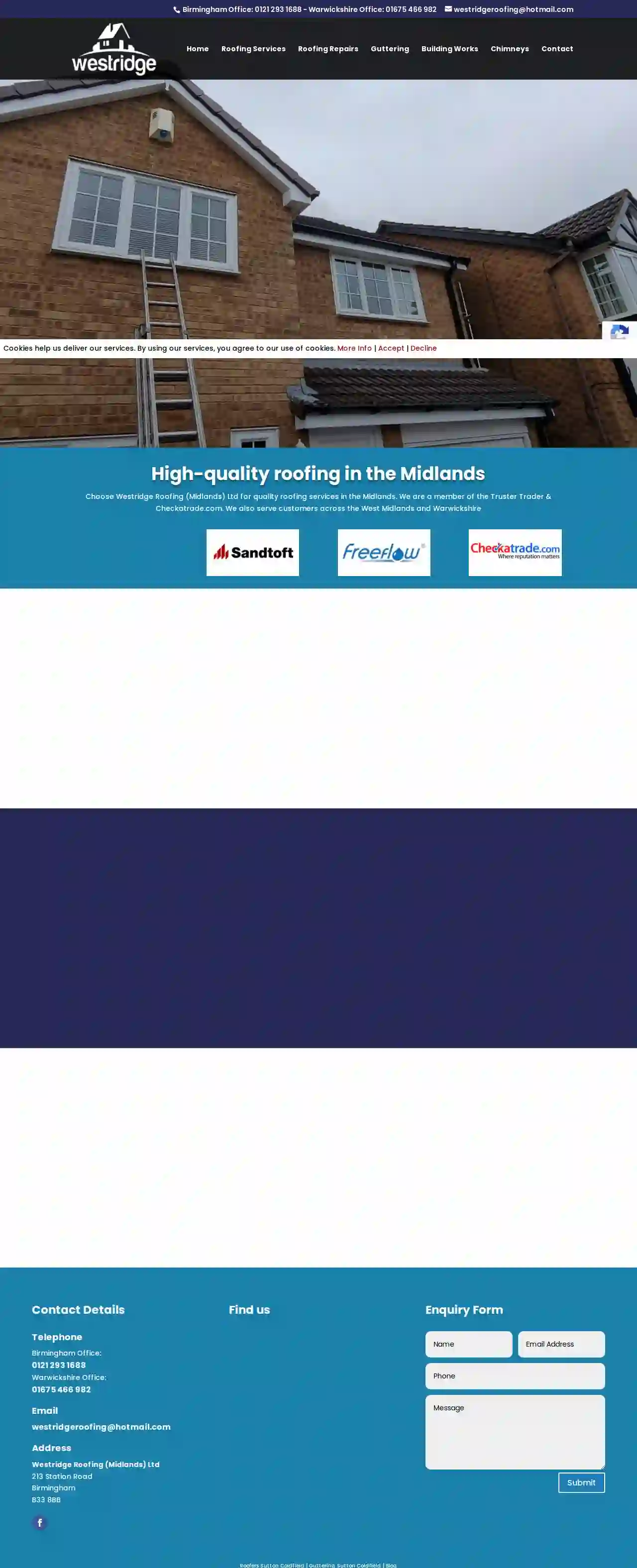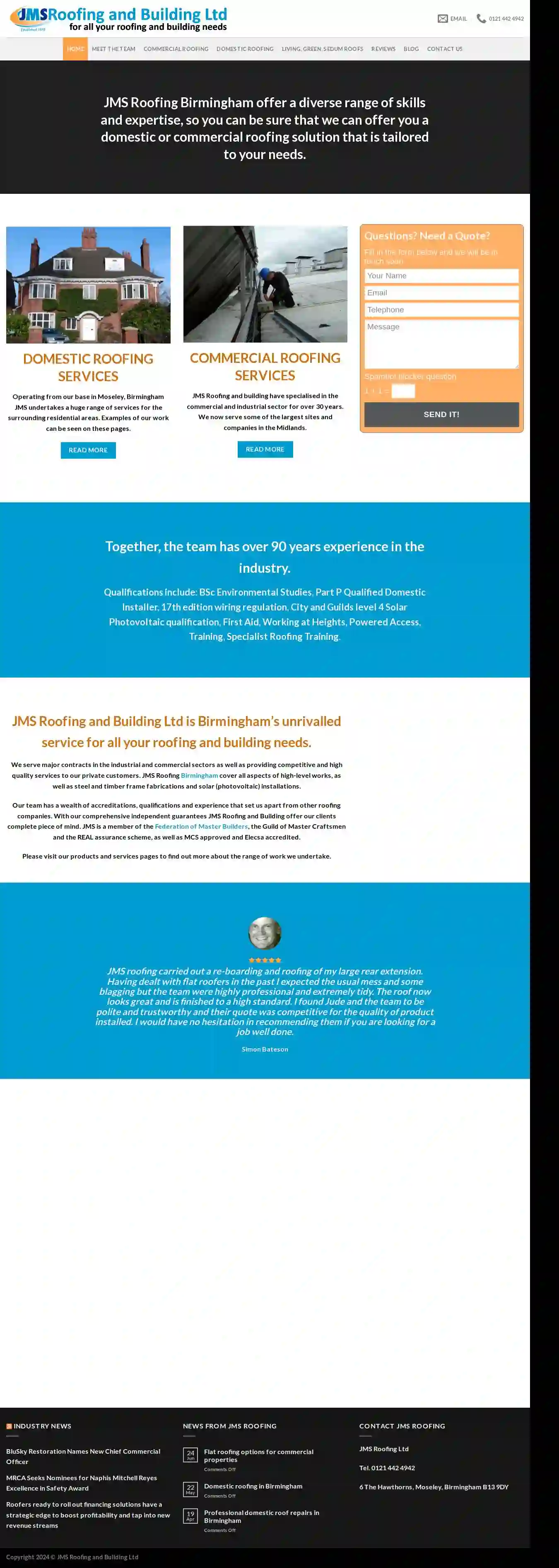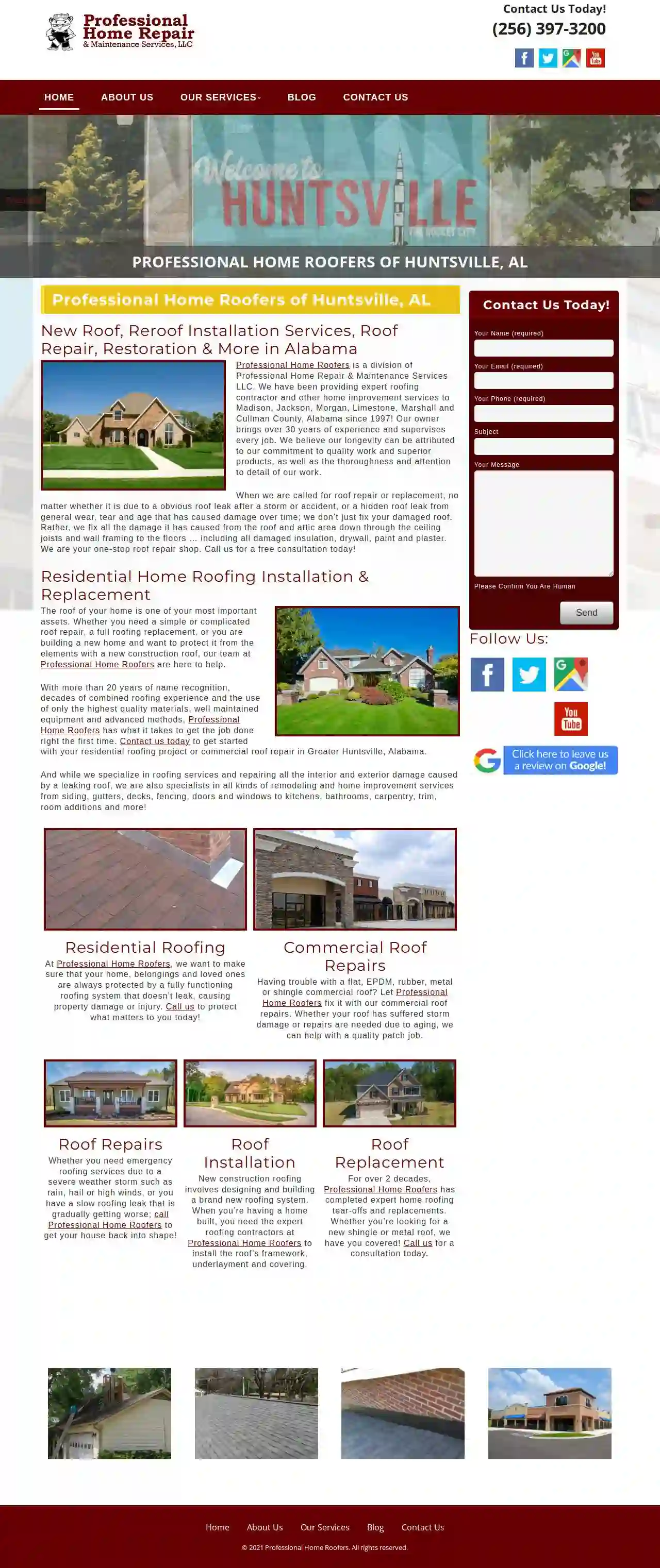Roofing Companies Fultondale
Find Roofing Company in Fultondale
Receive up to 3 Roofing Service quotes for your project today! Compare profiles, reviews, accreditations, portfolio, etc... and choose the best offer.

Continental Roofing Company, LLC
4.477 reviews8006 Old Madison Pike Suite 4, Madison, 35758, USAlabama's Reliable Roofing Contractor for Over 18 Years Continental Roofing Company - Locations in Huntsville, Birmingham, & Dothan View Services Schedule Free Estimate Commitment to Alabama Roofing Excellence For over 18 years, Continental Roofing has been Alabama's trusted roofing company. Based in Madison, AL, we proudly serve communities throughout Huntsville, Birmingham, and Dothan. As a leading roofing contractor equipped for handling residential and commercial projects, we are committed to deliver exceptional workmanship, unmatched roofing expertise, and a seamless experience from your initial inspection through project completion and beyond. Whether you need a new roof installation, roof repairs, or roof maintenance, we are here to provide top-notch solutions tailored to meet your specific needs. Why Choose Continental Roofing Company of Alabama Uncompromising Quality Protecting your Huntsville, Birmingham, or Dothan home or commercial space starts with a durable, reliable roof. At Continental Roofing, our GAF Master Elite-certified roofers with 18+ years of experience are dedicated to delivering exceptional workmanship. We use high quality roofing materials manufactured by GAF and installation techniques that go beyond simply nailing shingles. By focusing on the entire roof system, we ensure your roof withstands the harsh Alabama weather and provides worry-free protection for years to come. Experience & Expertise Having completed thousands of roofs spanning Huntsville to Dothan , Continental Roofing has developed a deep understanding of the unique challenges and requirements of Alabama roofing projects. Our team is equipped with a comprehensive skill set: experienced inspectors offering in-depth roof assessments and insurance claim assistance; skilled roof technicians capable of tackling any residential or commercial roofing project; and seasoned project managers, ensuring effective and efficient guidance throughout your roofing project. Personalized Roof Solutions At Continental Roofing, we know each roofing project is unique. Our team will take the time to listen to your concerns, assess your roof's condition, and provide tailored recommendations regarding repairs or replacements. We aim to offer practical and cost-effective roofing solutions that align with your vision and budget. Upon earning the privilege of being your roofing contractor, we customize job site protection utilizing The Catch-All system, safeguarding your property during the messy re-roofing process to ensure complete satisfaction. Superior Customer Service At Continental Roofing, we understand the importance of exceptional customer service. Our team is dedicated to providing a seamless experience from your initial inspection through project completion and beyond. We take pride in our commitment to quality, value, and superior customer service on every Alabama roofing project.
- Services
- Why Us?
- Gallery
Get Quote
Affordable Roofing Repair and Installation
542 reviewsUSAMERICAN Affordable Roofing & Construction Serving Huntsville, Guntersville, Arab, Cullman, Albertville, and Union Grove. 256-640-5941 GET A FREE QUOTE NOW ROOFING Services SIDING Services WINDOWS & DOORS Services CHECK FOR LEAKS Services CALL NOW AMERICAN Affordable Roofing And Construction Serving Huntsville, Guntersville, Arab, Cullman, Albertville, and Union Grove. 256-640-5941 -GET A FREE QUOTE NOW- ROOFING Service SIDING Service WINDOWS & DOORS Service CHECK FOR LEAKS Service CALL NOW AMERICAN Affordable Roofing and Construction Serving Huntsville, Guntersville, Arab, Cullman, Albertville, and Union Grove. 256-640-5941 GET YOUR FREE QUOTE NOW Our ROOFING Service Our SIDING Service Our WINDOWS & DOORS Service CHECK LEAKS Service CALL NOW AMERICAN Affordable Roofing / Construction Serving Huntsville, Guntersville, Arab, Cullman, Albertville, and Union Grove. 256-640-5941 GET A FREE QUOTE NOW ! ROOFING - Services SIDING- Services WINDOWS & DOORS- Services CHECK FOR LEAKS- Services CALL NOW AMERICAN-Affordable Roofing and Construction- Serving Huntsville, Guntersville, Arab, Cullman, Albertville, and Union Grove. 256-640-5941 GET A FREE QUOTE NOW !! Our ROOFING Services Our SIDING Services Our WINDOWS & DOORS Services CHECK LEAKS Service CALL NOW AMERICAN-Affordable Roofing And Construction- Serving Huntsville, Guntersville, Arab, Cullman, Albertville, and Union Grove. 256-640-5941 GET A FREE QUOTE NOW !!! ROOFING- Services - SIDING- Services - WINDOWS & DOORS- Services - CHECK FOR LEAKS - Services - CALL NOW AMERICAN-Affordable Roofing & Construction- Serving Huntsville, Guntersville, Arab, Cullman, Albertville, and Union Grove. 256-640-5941 GET A FREE QUOTE NOW !!!! ROOFING / Service SIDING / Service WINDOWS & DOORS / Service CHECK FOR LEAKS / Service CALL NOW Previous Next Your browser does not support the audio element. Get a Professional, Call us Now.ALABAMA ROOFING 256-640-5941 American Roofing and Construction LLC We Provide Repairs North Alabama ROOFING SERVICES American Roofing is a full-service roofing company that provides services for both residential and commercial properties. We have a team of experienced and qualified roofers who are dedicated to providing our customers with the highest quality of service. Whether you need a new roof for your home or your business, we can help. We offer a wide range of roofing services. ROOFING REPAIR SERVICE American Roofing and Construction LLC is a leading roofing and construction company that has been serving the community for over a decade. Our team of highly skilled and experienced professionals has over 30 years of combined experience in the construction and restoration industry.. We take pride in providing exceptional service, top-quality materials, and superior workmanship for all our projects, including roofing, siding, gutter guards, windows, and other construction and restoration services. Our commitment is to ensure your satisfaction every step of the way, so you can trust us to get the job done right the first time. Contact us today to learn more about how we can help with your construction or restoration needs. Services Offered Google Reviews What a few of our clients are saying right now on Google Reviews... Previous Sonia Christian I had a leak and made calls to get best price and Mr Hicks gave me the best price and came out and found the problem and fixed it where everyone else couldn't. Robert Overbeek Mike was the guy who contacted me and gave me a price for repairing my leaking roof vent, He was also the guy who did the work saving me the big markup from the "middle men" that seem to dominate these businesses now. About half the price, plus he repaired some other problems and charged me nothing extra. One of the "extras" he did for free was a job another guy wanted $250 to do.
- Services
- Why Us?
- Our Team
- Testimonials
- Gallery
Get Quote
Imperial Residential
4.858 reviewsBirch Road East, Unit 41, Birch Road Industrial Estate, Sutton Coldfield, B6 7DA, USWelcome to Imperial Residential Building & Roofing, a family run business with over 50 years experience in the construction industry. We are well placed to meet the individual requirements of your project, delivering general building and maintenance contracts across Birmingham and the wider West Midlands area. We offer all aspects of building maintenance, building upgrades, new roofing, roof refurbishment and roof repairs. Our experience and expertise enable us to deliver complex industrial and commercial based contracts, providing an all in one solution to a variety of residential, commercial and industrial clients.
- Services
- Why Us?
- Accreditations
- Our Team
- Testimonials
- Gallery
Get Quote
Mobile Roofing And Construction Saraland
58 reviewsMobile, USMOBILE ROOFING: 251-888-0301 Roof Repair, Roof Replacement, Mobile, Alabama Roofers, Insurance Claims SAVE UP TO 25% Off TODAY & (FREE ESTIMATE) Call 251-888-0301 NOW For FREE Inspection and Roof Estimate, In Mobile, Alabama. MOBILE ROOFING IN MOBILE ALABAMA 251-888-0301 Mobile's Number One Roofing Company Built On Integrity And Standard Mobile, AL: 251-888-0301 Protect your home with high-quality roofing installed by experienced professionals. We guarantee superior workmanship and complete satisfaction. Call Us Today for Roofing and Construction for service in Mobile, Alabama. We're your storm damage Pros! Call For Free Inspection & Estimate! If You Have Hail or Wind Damage, We Can Have You A New Roof Without Cost or Raising your Rate! 5 Ways to Know You Have Hired Good Roofing Contractors When starting to look for a residential or commercial roofer, it’s easy for your head to start spinning. There are many companies, and it can be hard to choose which one is going to be the best for your project. Here are several tips for knowing if you have found good roofing contractors (specifically in Mobile, Alabama). They Are Local. Choosing a local roofing contractor in Mobile, Alabama is important because only local contractors will understand the best roofs that can handle the harsh weather conditions. Considering the extreme cold, heavy snow and the humid summers we experience, having a roof that can keep your building protected is a must. In addition, choosing a local roofer benefits the local economy. They Experience Continued Safety Training. A company that executes continual safety training of employees is a great quality to look for when considering hiring a residential or commercial roofing company. Our Company is proactive in staying compliant with federal, state and local safety standards. All of our employees receive training in health and safety, first aid and CPR, right to know, fall protection and many other types of training. They Are Properly Licensed. This is perhaps one of the most important things when choosing a contractor for any type of job. Make sure that they have a license. This is proof that the company knows what they are doing and they know codes and laws specific to the project. Central roofing is licensed in many states Alabama. Not only are we licensed; we hire the most qualified and skilled professionals in the field to complete our projects. They Have Good Reviews. Reading reviews about potential commercial roofing companies will give you a good idea of their abilities from real customers. Getting an honest answer from actually people who have used a company’s services will help you weed through the good, the bad and the ugly. Knowing the reputation of the company will help you know that your money will go to the right people. Their Pricing is Fair. It is fair to desire a reasonable price for a commercial roofing project. Being the preferred commercial roofers throughout the Mobile Alabama region should give you the right impression that the rates quoted by us will be fair. Knowing there are many companies that would love to take on your commercial project, you can be sure that the pricing is going to be competitive but the value and quality of our work exceeds the cost. Keeping all of these tips in mind will make your decision a lot easier. Knowing that a company understands the climate in Alabama is crucial for making sure the job is done correctly. Hiring a company with the proper license, that offers safety training for their employees, has good reviews and fair pricing means that you found the right company.
- Services
- Why Us?
- Gallery
Get Quote
Westridge Roofiing & Building Services Ltd
54 reviewsBirmingham, 213 Station Road, B33 8BB, USHigh-quality roofing in the Midlands Choose Westridge Roofing (Midlands) Ltd for quality roofing services in the Midlands. We are a member of the Truster Trader & Checkatrade.com. We also serve customers across the West Midlands and Warwickshire A comprehensive range of roofing services Westridge Roofing (Midlands) Ltd is a well-established roofing and building company in the Midlands. From a minor repair to a complete new roof, you can rely on our skilled roofers to get the job done. We are members of Trust a Trader and Checkatrade. For your peace of mind, we also offer a 10 year guarantee on all our services. Call us for a free, no-obligation quote. A team of dedicated staff All our staff are highly skilled and well trained. We will visit your property, discuss your requirements in detail and strive hard to fulfil your needs. What sets us apart? Wealth of experience in the business Free, no-obligation quotes Quality workmanship All our services are fully guaranteed We are fully insured For more information, speak to us today.
- Services
- Why Us?
- Accreditations
- Gallery
Get Quote
JMS Roofing & Building Ltd
4.820 reviews6 The Hawthorns, Moseley, B13 9DY, USJMS Roofing and Building Ltd is Birmingham’s unrivalled service for all your roofing and building needs. We serve major contracts in the industrial and commercial sectors as well as providing competitive and high quality services to our private customers. JMS Roofing Birmingham cover all aspects of high-level works, as well as steel and timber frame fabrications and solar (photovoltaic) installations. Our team has a wealth of accreditations, qualifications and experience that set us apart from other roofing companies. With our comprehensive independent guarantees JMS Roofing and Building offer our clients complete piece of mind. JMS is a member of the Federation of Master Builders, the Guild of Master Craftsmen and the REAL assurance scheme, as well as MCS approved and Elecsa accredited. Please visit our products and services pages to find out more about the range of work we undertake.
- Services
- Why Us?
- Accreditations
- Our Team
- Testimonials
- Gallery
Get Quote
Roofing World
529 reviewsHuntsville, USRoofing World® Has The Biggest Selection, Lifetime Warranties, Best Prices… Guaranteed!™ Get 20% off Material & Labor… Average savings of $5,000 by filling out this form ✔ Roofing World serves ALL of Alabama and Georgia 2024 ROOFING SOLUTIONS PROVIDER OF THE YEAR. ~ Construction Business Review Magazine Need A Free Estimate? Fill out this simple form to Claim Your 20% Coupon Code and to get started with your free estimate. ✔ Roofing World serves ALL of Alabama and Georgia 2024 ROOFING SOLUTIONS PROVIDER OF THE YEAR. ~ Construction Business Review Magazine Roofing Replacement Services in Huntsville, AL ★★★★★ “By far the best experience, the best knowledge, the best workmanship, and they did everything they said they would, plus they went the extra mile! Watch out competitors, I’m willing to bet these guys will erase some of you before the end of the year with little or no effort! Integrity, kindness, and honesty is resurfacing in Bham AL! Great things are on the way!!” – Customer Sterling Ross Get A Free Estimate A Five-Star Team Excellent Customer Service Is our priority! Our knowledgeable staff will help you every step of the way. From the first call to our office, throughout your roof project process until the final walk-through, you can expect courteous, friendly technicians to answer every question and explain every detail. No one offers more financing choices than Roofing World® We have over 100 different plans with payments as low as $89/mo. Get up to $65,000 for your project today! Our financing starts with a soft pull that will not impact your credit score. We can find a financing plan to fit virtually all situations including weak and low credit! Call our roofing experts to discuss the best option for your budget, or apply now using the form on this page. BEST PRICES At Roofing World®, we are serious about offering the best value of any roofing company. Apples to apples, no one beats our prices! With our superior distribution network of suppliers combined with our buying power, we have the ability to offer the best possible prices. When you choose to get a roof replacement with us, we guarantee our workmanship. Get A Free Estimate Our Roofing Services When you choose Roofing World® for your roof replacement, we have developed a world-class roofing process that results in a durable high-quality roof. Metal Roofing Installation Asphalt Roofing Installation Poly Shingle™ Installation TPO Gutter Installation Gutter Guards Get A Free Estimate Experience roofing excellence in Huntsville, AL, with Roofing World as your trusted partner. Our team of skilled roofing specialists collaborates closely with you to create a tailored design for your roofing installation or replacement project. Committed to quality and durability, Roofing World offers a comprehensive selection of roofing materials, ensuring a seamless integration of style and functionality. Whether you’re enhancing the charm of a residential property or fortifying the structure of a commercial space, our commitment to superior craftsmanship makes us the preferred choice for roofing solutions in Huntsville. Connect with Roofing World today to embark on a roofing journey that transforms your Huntsville property into a showcase of enduring beauty. Lifetime Warranties We stand behind our work with Lifetime Warranties on materials and labor on any of our World-Class Collection Products We Stand Behind Our Work World Class Installation Process Onsite Installation Manager Most roofing companies offer one to three years of workmanship warranties but Roofing World® stands behind its work for as long as
- Services
- Why Us?
- Accreditations
- Testimonials
- Gallery
Get Quote
LMD Conservatory Roofs
516 reviews307 Lichfield Road, Four Oaks, Sutton Coldfield, B74 4BZ, USLMD Conservatory Roofs is a leading provider of conservatory roof replacement and installation services in the UK. With years of experience and a team of expert professionals, we offer a wide range of conservatory roof solutions to suit your needs and budget. Our services include replacement conservatory roofs, tiled conservatory roofs, solid roof conservatory, and more. We serve various areas, including Derbyshire, Leicestershire, Nottinghamshire, Staffordshire, Warwickshire, and West Midlands. Contact us today to request a quote and learn more about our services.
- Services
- Why Us?
- Gallery
Get Quote
Wright's Roofing & Contracting
4.838 reviewsMontgomery AL, Montgomery, 36110-2836, USLarry Wright has been the Montgomery area's roofing and home improvement specialist for nearly 30 years. Every job Larry and his crew do isn't finished until our customers are satisfied. We provide a complete range of services for all your roofing needs. From new construction projects to old home restorations, we can do it all. No matter the size of the job, you can count on us to deliver quality workmanship and exceptional customer service. We're more than just roofers: We're masters of our craft. We combine a comprehensive understanding of our field with rigorous training, education, and experience. Our high level of expertise pays off in dividends for our clients. It allows us to deliver a superior standard of service, more efficient workmanship, and stellar results on every job. As a roofing company, we strive to develop smart solutions that save our customers time and money. We stick to our deadlines, and we consistently stay well under our clients’ budgets while ensuring excellent quality control. Rest assured: When you choose us, you can take comfort knowing you’ve chosen well. You’ve chosen the best in the business.
- Services
- Why Us?
- Accreditations
- Our Team
- Testimonials
- Gallery
Get Quote
Professional Home Roofers
10000 University Dr, Suite 100, Huntsville, 35801, USProfessional Home Roofers of Huntsville, AL is a division of Professional Home Repair & Maintenance Services LLC. Serving Madison, Jackson, Morgan, Limestone, Marshall and Cullman County, Alabama since 1997, we offer expert roofing contractor and other home improvement services. Our owner brings over 30 years of experience and supervises every job. We believe our longevity can be attributed to our commitment to quality work and superior products, as well as the thoroughness and attention to detail of our work. When we are called for roof repair or replacement, no matter whether it is due to a obvious roof leak after a storm or accident, or a hidden roof leak from general wear, tear and age that has caused damage over time; we don’t just fix your damaged roof. Rather, we fix all the damage it has caused from the roof and attic area down through the ceiling joists and wall framing to the floors … including all damaged insulation, drywall, paint and plaster. We are your one-stop roof repair shop. We specialize in roofing services and repairing all the interior and exterior damage caused by a leaking roof, but we also offer a wide range of remodeling and home improvement services from siding, gutters, decks, fencing, doors and windows to kitchens, bathrooms, carpentry, trim, room additions and more!
- Services
- Why Us?
- Accreditations
- Gallery
Get Quote
Over 17,196+ Roofing Companies onboarded
Our roofing contractors operate in Fultondale and surroundings!
Roofyng.com has curated and vetted the Best Roofing Companies in and around Fultondale. Find a trustworthy pro today.
Frequently Asked Questions About Roofing Companies
- Roof size and complexity
- Roofing material chosen
- Local labor costs
- Accessibility of the roof
- Removal of existing roofing
- Additional features (skylights, chimneys, etc.)
- Regular Inspections: Inspect your roof at least twice a year for signs of damage or wear and tear.
- Gutter Cleaning: Clean gutters and downspouts regularly to prevent clogs and ensure proper drainage.
- Tree Trimming: Trim overhanging branches to avoid damage from falling debris and reduce shade, preventing moss growth.
- Proper Ventilation: Ensure good attic ventilation to regulate temperature and moisture.
- Timely Repairs: Address any damage promptly to prevent escalation.
- Age: If your roof is nearing or exceeding its expected lifespan, it's wise to consider replacement.
- Multiple Leaks: Several leaks or leaks that reappear after repairs suggest a widespread problem.
- Extensive Damage: Large areas of damaged, missing, or deteriorated roofing materials might be too costly or difficult to repair effectively.
- Sagging or Structural Issues: Sagging, deflection, or other structural issues indicate a compromised roof that needs replacement.
- Granule Loss (Asphalt Shingles): Significant granule loss indicates weathering and reduced protection.
- Curling or Buckling Shingles: Signifies age or improper ventilation.
- Increased Energy Bills: A poorly insulated roof can lead to higher heating and cooling costs.
How much does a new roof cost in the USA?
How do I prevent roof damage?
What are the signs that my roof needs to be replaced?
What should I do with my old roof after replacement?
How much does a new roof cost in the USA?
- Roof size and complexity
- Roofing material chosen
- Local labor costs
- Accessibility of the roof
- Removal of existing roofing
- Additional features (skylights, chimneys, etc.)
How do I prevent roof damage?
- Regular Inspections: Inspect your roof at least twice a year for signs of damage or wear and tear.
- Gutter Cleaning: Clean gutters and downspouts regularly to prevent clogs and ensure proper drainage.
- Tree Trimming: Trim overhanging branches to avoid damage from falling debris and reduce shade, preventing moss growth.
- Proper Ventilation: Ensure good attic ventilation to regulate temperature and moisture.
- Timely Repairs: Address any damage promptly to prevent escalation.
What are the signs that my roof needs to be replaced?
- Age: If your roof is nearing or exceeding its expected lifespan, it's wise to consider replacement.
- Multiple Leaks: Several leaks or leaks that reappear after repairs suggest a widespread problem.
- Extensive Damage: Large areas of damaged, missing, or deteriorated roofing materials might be too costly or difficult to repair effectively.
- Sagging or Structural Issues: Sagging, deflection, or other structural issues indicate a compromised roof that needs replacement.
- Granule Loss (Asphalt Shingles): Significant granule loss indicates weathering and reduced protection.
- Curling or Buckling Shingles: Signifies age or improper ventilation.
- Increased Energy Bills: A poorly insulated roof can lead to higher heating and cooling costs.